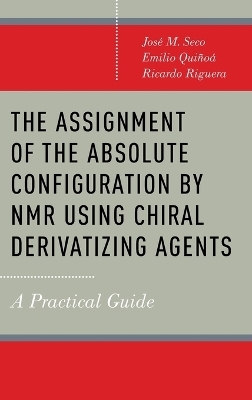
The Assignment of the Absolute Configuration by NMR using Chiral Derivatizing Agents
A Practical Guide
Seiten
2015
Oxford University Press Inc (Verlag)
978-0-19-999680-3 (ISBN)
Oxford University Press Inc (Verlag)
978-0-19-999680-3 (ISBN)
The Assignment of the Absolute Configuration by NMR using Chiral Derivatizing Agents: A Practical Guide briefly explains the theoretical aspects necessary for understanding the methodology of new research in the field of Nuclear magnetic resonance spectroscopy (NMR).
Nuclear magnetic resonance spectroscopy (NMR spectroscopy) is a research technique that uses the magnetic properties of atomic nuclei to determine physical and chemical properties of atoms or the molecules in which they are contained. Proton NMR (1H NMR) is a technique that applies NMR spectroscopy specifically to the hydrogen-1 nuclei within the molecules of a substance, in order to determine the structure of that substance's molecules. The use of 1H NMR for the assignment of absolute configuration of organic compounds is a well-established technique. Recent research describes the technique's application to mono-, bi- and trifunctional compounds. In addition, several new auxiliary reagents, mono- and biderivatization procedures, on-resin methodologies and more recently, the use of 13C NMR, have been introduced to the field.
In The Assignment of the Absolute Configuration by NMR using Chiral Derivatizing Agents: A Practical Guide, eminent Professor of Organic Chemistry Ricardo Riguera organizes this cutting-edge NMR research. Professor Riguera offers a short and usable guide that introduces the reader to the research with a plethora of details and examples. The book briefly explains the theoretical aspects necessary for understanding the methodology, dedicating most of its space to covering the practical aspects of the assignment, with examples and spectra taken from the authors' own experiments. Upper-level undergraduates, graduate students, and chemical researchers will find this guide useful for their studies and practice.
Nuclear magnetic resonance spectroscopy (NMR spectroscopy) is a research technique that uses the magnetic properties of atomic nuclei to determine physical and chemical properties of atoms or the molecules in which they are contained. Proton NMR (1H NMR) is a technique that applies NMR spectroscopy specifically to the hydrogen-1 nuclei within the molecules of a substance, in order to determine the structure of that substance's molecules. The use of 1H NMR for the assignment of absolute configuration of organic compounds is a well-established technique. Recent research describes the technique's application to mono-, bi- and trifunctional compounds. In addition, several new auxiliary reagents, mono- and biderivatization procedures, on-resin methodologies and more recently, the use of 13C NMR, have been introduced to the field.
In The Assignment of the Absolute Configuration by NMR using Chiral Derivatizing Agents: A Practical Guide, eminent Professor of Organic Chemistry Ricardo Riguera organizes this cutting-edge NMR research. Professor Riguera offers a short and usable guide that introduces the reader to the research with a plethora of details and examples. The book briefly explains the theoretical aspects necessary for understanding the methodology, dedicating most of its space to covering the practical aspects of the assignment, with examples and spectra taken from the authors' own experiments. Upper-level undergraduates, graduate students, and chemical researchers will find this guide useful for their studies and practice.
Ricardo Riguera is Professor of Organic Chemistry at the University of Santiago. He is the author of 200 papers and patents covering bioactive natural products, medicinal chemistry and NMR methods for determination of absolute configuration.
Table of Contents ; Chapter 1 The theoretical basis for the assignment by NMR ; Chapter 2 Practical aspects for the preparation of the derivatives ; Chapter 3 Assignment of the absolute configuration of monofunctionalcompounds by double derivatization ; Chapter 4 Assignment of the absolute configuration of monofunctional compounds by single derivatization ; Chapter 5 Assignment of the absolute configuration of polyfunctional compounds ; Chapter 6 Exercises
| Erscheint lt. Verlag | 9.7.2015 |
|---|---|
| Zusatzinfo | 244 illustrations |
| Verlagsort | New York |
| Sprache | englisch |
| Maße | 234 x 160 mm |
| Gewicht | 499 g |
| Themenwelt | Naturwissenschaften ► Biologie ► Biochemie |
| Naturwissenschaften ► Chemie ► Analytische Chemie | |
| ISBN-10 | 0-19-999680-6 / 0199996806 |
| ISBN-13 | 978-0-19-999680-3 / 9780199996803 |
| Zustand | Neuware |
| Haben Sie eine Frage zum Produkt? |
Mehr entdecken
aus dem Bereich
aus dem Bereich


